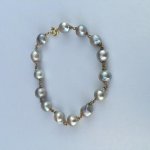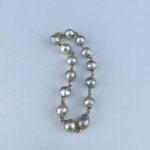Hi Dave and All,
I am hoping you can "read" my candling photos for me. These are photos of two rings I have. I know the photos are not perfect but at the time I only had my camera to use. I bought 2 USB microscopes and one has arrived but not with a readable CD - one of those tiny ones that are useless for most computers. I am downloading drivers I hope will work on my mac. The other microscope seems to be totally lost in the US postal system. Seller sent it via USP and it ended up delivered to some firm in the US after I paid $30 for a fast delivery. Grrrrr
I will add photos of other items later. Sometimes (often) I am not really sure what I am seeing. Need to learn what I am seeing.
I have other photos but thought to get opinions on these first. I believe both are natural pearls. At the moment I still sometimes get a halo around the pearls or the light shines straight through them. The 3 light system may be too much light, not sure.
As a set up I am using an 80mm x 55mm box with a 3 light torch in it. That can be used easily just by pushing on the top to turn on and off. The lid is tight so no light escapes that way and no need for a cord or wire out the side of the box. Also using Blu Tack to cover any holes not in use and after a few tries decided to use it on top as well by cutting a small square of Blu Tack and using the Wad Punch to cut a hole in that too. That helps to keep light from glaring out around the pearl.
I have set 3 boxes up with 3 holes in each of varying sizes. Have more boxes so will probably try out different types and sizes of holes to look at strands once I get a microscope working. The boxes and little battery light were cheap. It is just a matter of changing the lids for different hole sizes.
Sorry about blurry photo of set up but the extra lenses were still on the camera.
Dawn - Bodecia
http://www.ebay.com/sch/dawncee333/m.html
eBay Seller ID dawncee333 Natural pearl collector & seller. And all round pearl lover.


